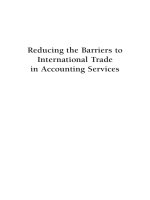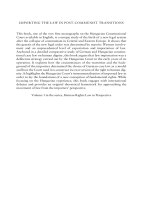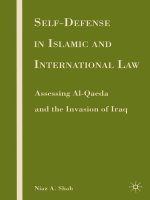International Law in Antiquity potx
Bạn đang xem bản rút gọn của tài liệu. Xem và tải ngay bản đầy đủ của tài liệu tại đây (1.7 MB, 345 trang )
This page intentionally left blank
International Law in Antiquity
This study of the origins of international law combines
techniques of intellectual history and historiography to
investigate the earliest developments of the law of nations.
The book examines the sources, processes, and doctrines of
international legal obligation in antiquity to reevaluate the
critical attributes of international law. David J. Bederman
focuses on three essential areas in which law influenced
ancient State relations – diplomacy, treaty-making, and
warfare – in a detailed analysis of international relations
in the Near East (2800–700 BCE), the Greek city-States
(500–338 BCE), and Rome (358–168 BCE). Containing up-to-date
literature and archeological evidence, this study does not
merely catalogue instances of recognition by ancient States
of these seminal features of international law: it accounts
for recurrent patterns of thinking and practice. This
comprehensive analysis of international law and State
relations in ancient times provides a fascinating study for
lawyers and academics, ancient historians and classicists
alike.
david j. bederman is Professor of Law at Emory
University’s School of Law in Atlanta, Georgia. His previous
publications cover such diverse subjects as international
legal theory and history, the law of the sea and international
environment, the law of State responsibility and international
claims, US constitutional law of foreign relations, and
maritime law.
cambridge studies in international and
comparative law
This series (established in 1946 by Professors Gutteridge, Hersch Lauterpacht and
McNair) is a forum for high quality studies in the fields of public and private
international and comparative law. Although these are distinct sub-disciplines,
developments since 1946 confirm their interrelationship. Comparative law is
increasingly used as a tool in the making of law at national, regional and
international levels. Private international law is now often affected by
international conventions, and the issues faced by classical conflicts rules are
frequently dealt with by substantive harmonisation of law under international
auspices. Mixed international arbitrations, especially those involving state
economic activity, raise mixed questions of public and private international law,
while in many fields (such as the protection of human rights and democratic
standards, investment guarantees, and international criminal law) international
and national systems interact. National constitutional arrangements relating to
“foreign affairs”, and to the implementation of international norms, are a focus
of attention.
Professor Sir Robert Jennings edited the series from 1981. Following his
retirement as General Editor, an editorial board has been created and Cambridge
University Press has recommitted itself to the series, affirming its broad scope.
The board welcomes works of a theoretical or interdisciplinary character, and
those focusing on new approaches to international or comparative law or
conflict of law. Studies of particular institutions or problems are equally
welcome, as are translations of the best work published in other languages.
General Editors James Crawford
David Johnston
Editorial Board Professor Hilary Charlesworth University of Adelaide
Mr John Collier Trinity Hall, Cambridge
Professor Lori Damrosch Columbia University Law School
Professor John Dugard Director, Research Centre for
International Law, University of Cambridge
Professor Mary-Ann Glendon Harvard Law School
Professor Christopher Greenwood London School of
Economics
Professor Hein Kötz Max-Planck-Institut, Hamburg
Professor D. M. McRae University of Ottawa
Professor Onuma Yasuaki University of Tokyo
Advisory Committee Professor D. W. Bowett QC
Judge Rosalyn Higgins QC
Professor Sir Robert Jennings QC
Professor J. A. Jolowicz QC
Professor Sir Eli Lauterpacht QC
Professor Kurt Lipstein
Judge Stephen Schwebel
A list of books in the series can be found at the end of this volume
International Law in Antiquity
David J. Bederman
The Pitt Building, Trumpington Street, Cambridge, United Kingdom
The Edinburgh Building, Cambridge CB2 2RU, UK
40 West 20th Street, New York, NY 10011-4211, USA
477 Williamstown Road, Port Melbourne, VIC 3207, Australia
Ruiz de Alarcón 13, 28014 Madrid, Spain
Dock House, The Waterfront, Cape Town 8001, South Africa
First published in printed format
ISBN 0-521-79197-9 hardback
ISBN 0-511-03166-1 eBook
David J. Bederman, 2004
2001
(Adobe Reader)
©
For my Father,
who sets the highest standards
Contents
Acknowledgmentspage xi
List of abbreviationsxiii
Mapsxiv
1
A methodological introduction: this study and its
limitations1
Times and places2
Comparison and relativism4
Sources, process, and doctrines6
Texts and sources8
The modern critique of ancient international law11
2State relations in ancient civilizations16
The concepts of State and State system and their relevance to antiquity16
The ancient Near East: Mesopotamia, Syria, and Egypt21
Sumer and Mesopotamia22
The great Near Eastern empires, 1400–1150 BCE24
Syria and Palestine, 966–700 BCE28
The Greek city-States, 500–338 BCE31
Rome and its competitors, 358–168 BCE41
3 Religion and the sources of a la
w of nations in antiquity
48
The metaphysics of ancient international law51
Good faith and breaking faith51
Four fragments54
Religion59
Nationalism and universalism59
Making and breaking oaths61
Ritual and custom73
Reason and rhetoric79
Conclusion85
ix
4 Making friends: diplomats and foreign visitors in ancient
times88
The reception and protection of diplomats and embassies88
Some general concepts88
The formalities of diplomacy95
Privileges and immunities of diplomats106
The status and protection of alien visitors120
Agreements: xenoi,asylia,isopoliteia, andsymbola124
The proxeniainstitution130
Western Mediterranean analogues134
Ritualized friendship in an ancient law of nations135
5Making faith: treaty practices amongst ancient peoples137
Beginnings of the ancient treaty tradition in the Near East137
General suppositions and the earliest texts137
The Babylonians, Hittites, and Assyrians141
The Egyptians and the treaty with the Hittites of 1280 BCE146
Ancient Israelite practice150
The Greek city-States154
Terminology and types of treaties154
The nature of Greek treaty
-making171
Western Mediterranean departures in treaty-making183
Patterns of treaty-making by Western Mediterranean
cultures183
Formalities and enforcement of Roman treaties194
Ancient treaty-making: enforcement, sophistication,
tradition, and universality202
6 Making war: the commencement and conduct of
hostilities in ancient times207
Declarations of war
208
Justifications for commencing hostilities208
The rituals for starting a war and the legal
consequences of an outbreak of hostilities227
Laws of war242
Restraint in warfare242
Immunities in warfare249
After the war260
Managing conflict in antiquity263
7Civilization and community in the ancient mind267
Topical bibliography281
Index303
x contents
Acknowledgments
This book has been over a decade in the making. It began its life as my
dissertation for a PhD in Laws at the University of London. In that stage of
development, I was grateful to Professor (now Judge) Rosalyn Higgins and
Professor Patricia Birnie at the London School of Economics, who both pro-
vided valuable guidance at the early, planning stages of this project. At the
conclusion of writing, I was given significant direction by Professor William
E. Butler of University College London, and by Professor James Crawford of
Cambridge University.
I havealso immensely profited from countless conversations with scoresof
colleagues and scholars, drawn from the international law, classics, ancient
history, and political theory disciplines. It would be impossible for me to
credit all of these contacts, but I would particularly acknowledge the advice
of such people as Robert Bauslaugh, Hal Berman, Michael Broyde, Herbert
Hausmaninger, Mark Janis, David Kennedy, Martti Koskenniemi, Benedict
Kingsbury, Charles Reid, Cees Roelofsen, Alan Watson, and John Witte.
I owe a special debt of g
ratitude to Professor Aldo Lupi of Georgia State
University, who took such especial care in checking and correcting my Latin
and Greek usages, and to Professor Michael Broyde, of Emory University
School of Law, who reviewed my ancient Hebrew terminology.
The dauntingly broad scope of this work placed heavy burdens on the
many reference librarians that I have been privileged to be associated with
in my career. I owe a substantial debt to the librarians of the Peace Palace
Library in The Hague; the University of Virginia School of Law Library; and,
most of all, to my colleagues at the Emory University School of Law, Robert
W. Woodruff, and Pitts Theological Libraries.
I should also point out that an early version of what is now Chapter 3 of
this volume appeared in a collection of essays entitled The Influence of Relig-
ion on the Development of International Law (Mark W. Janis, ed. 1991 & 1999).
xi
Finally, I must acknowledge the sacrifices of my wife and daughter. Any
scholar’s commitment to a project of this sort comes always at a substantial
cost to one’s family. I just hope that the costs have been modest enough, and
compensated (to some degree) with my attention, respect, and love.
As always, I fully accept responsibility for the errors and omissions found
in this volume. Despite my best efforts, I am sure many will be identified.
Interdisciplinary scholarship is always a risky undertaking, and a book of
this scope and thrust is perhaps even more fraught with reputational
danger. I can only hope that a gentle and patient reader will find it a useful
contribution to our understanding of ancient peoples and their engage-
ment with a rule of law for international relations.
xii acknowledgments
Abbreviations
AJIL American Journal of International Law
AJP American Journal of Philology
ARMT Archives Royales de Mari
BASOR Bulletin of the American Schools of Oriental
Research
BYIL British Yearbook of International Law
CP Classical Philology
CQ Classical Quarterly
Eastern JIL Eastern Journal of International Law
GRBS Greek, Roman and Byzantine Studies
Indian JIL Indian Journal of International Law
Indian YBIA Indian Yearbook of International Affairs
JAOS Journal of the American Oriental Society
JHS Journal of Hellenic Studies
JNES Journal of Near Eastern Studies
Netherlands ILR Netherlands International Law Review
PCPhS Proceedings of the Classical Philology Society
RCADI Recueil des Cours de l’Academie de Droit
International de la Haye
REG Revue des Etudes Grecques
RGDIP Revue Generale de Droit International Public
RIDA Revue Internationale des Droits de l’Antiquité (ser. 3)
xiii
0
0 100
100
200 300 Km
200 Miles
Khattusha
PITASHSHA
WALMA
KARKISHA
MASHA
SHEKHA-RIVER
LAND
ZIPPASHLA
WILUSA
LUKKA
ASHSHUWA
AHHIYAWA ??
32°28°
40°
28°
32°
36°
P
A
L
A
T
U
M
A
N
N
A
?
P
A
R
T
A
K
H
U
I
N
A
A
R
Z
A
W
A
K
H
A
P
A
L
L
A
M
I
R
A
-
K
U
W
A
L
I
Y
A
C
Y
P
R
U
S
A
L
A
S
H
I
Y
A
C
R
E
T
E
Map 1 Ancient Near East (reproduced from the Cambridge Ancient
History, volume 2, Part 2, 3rd edn, 1975)
Shallapa
Kanesh
Tuwanuwa
Tegarama
Malatya
Kumanni
ALSHE
MITANNI
ASHTATA
NUKHASH LANDS
SIYANNI
AMURRU
KHURRI
Kutmar
Washshuganni
Harranu
Ninua
36°
Ashur
44°
Mari
Apina
Batrun
Gubla
Beruta
Sidon
Tyre
Kinza
Qatna
AZZI
Arinna?
Gaziura
Nerik?
Khakpish?
Carchemish
Alalakh
Khalba
Ugarit
40°
44°40°
36°
40°36°
‘
A
M
Q
A
M
a
l
a
R
.
R
.
T
i
g
r
i
s
P
u
r
a
tt
u
(
R
.
E
u
p
h
r
a
t
e
s
)
K
I
Z
Z
U
W
A
D
N
A
M
a
r
a
s
h
s
h
a
n
i
y
a
R
.
K
A
S
K
E
A
N
S
K
H
A
Y
A
S
H
A
I
S
H
U
W
A
Map 2 Greece (reproduced from the Cambridge Ancient History, volume 5,
2nd edn, 1992)
History, volume 7, Part 2, 2nd edn, 1989)
1 A methodological introduction: this study
and its limitations
This is a study of the intellectual origins of international law. This volume
combines techniques of intellectual history and historiography in order to
account for the earliest developments in the sources, processes and doc-
trines of the law of nations. This combination of methods is not only
essential for considering the earliest formation of ideas of international
law, but also for beginning an understanding of the manner in which
those ideas have been received by modern publicists and the extent to
which they have been recognized in the modern practice of States.
My book will thus critically examine what has become an article of faith
in our discipline: that international law is a unique product of the
modern, rational mind. I argue here that it is not. While this volume
charts the intellectual impact of the idea of ancient international law, it
purposefully ignores the appreciation of this subject by historians, politi-
cal scientists and internationalists. My study, moreover, confines itself to
the single inquiry of whether the ancient mind could and did conceive of
a rule of law for international relations. I certainly do not attempt to argue
or suggest here that modern principles or doctrines of international law
can be traced to antiquity. Nor do I pronounce judgment on the exact
manner in which the ancient tradition of international law was received
in early-Modern Europe or after. These inquiries must be left for later
research and discussion. I confront here, therefore, an ancient law of
nations on its own terms. By doing so, I am making a start on a broader
vision of the intellectual origins of our discipline.
Intellectual history is, after all, the story of ideas. International law,
even when considered as an historical subject, is typically conceived as a
collection of rules motivated by international relations. Rarely is it viewed
as a cogent theory of State relations. One thrust of this book will test such
a theory against the historical circumstances of the ancient world. In
1
order to do this, my study accepts the notion that international law is
impossible without a system of multiple States, each conscious of its own
sovereignty and the choice between relations being premised on order or
on anarchy.
1
Times and places
As a consequence of these conceptual limitations, this volume will be
limited to three general periods of antiquity. They are (1) the ancient Near
East including the periods subsuming the
Sumerian city-States, the great
empires of Egypt, Babylon, Assyria and the Hittites (1400–1150 BCE), and a
later, brief period focusing on the nations of Israel and their Syrian neigh-
bors (966–700 BCE); (2) the Greek city-States from 500–338 BCE; and (3) the
wider Mediterranean during the period of Roman contact with Carthage,
Macedon, Ptolemaic Egypt, and the Seleucid Empire (358–168 BCE). I am
mindful, of course, that the temporal and geographical scope of this study
is huge. But it is not insuperable. I have chosen with care the times and
places in antiquity for review; in each one there is an undisputed, and
authentic, system of States in place. The evidence for this proposition will
be detailed in Chapt
er 2.
By the same token, I do acknowledge that there is some arbitrariness in
the dates and localities selected for research in this book. As Professor
Wolfgang Preiser wrote in his recent abstract of the history of interna-
tional law in antiquity:
We accept that writers of history of international law must . . . be allowed to apply
the intellectual principle of order called categorization by period which is utilized
by all historians, irrespective of specialization, when they perceive their task to be
the comprehension respectively of an uninterrupted flow of events. It is regret-
table that a living process should be thus divided into chronological and loca-
tional sections; yet, taking our limited powers of absorption into consideration, it
cannot be avoided.
2
This defense of historiographic method is especially pertinent in my
study, attempting (as it does) to trace the patterns of State practice
amongst different peoples and State organizations at very different times
in antiquity.
2 methodological introduction
1
See Vilho Harle, Ideas of Social Order in the Ancient World 91–100, 165–68, 171–74 (1998);
Georg Schwarzenberger, International Law in Early English Practice, BYIL 52, 52 (1948).
2
Wolfgang Preiser, History of the Law of Nations: Basic Questions and Principles, in 7
Encyclopedia of Public International Law 126, 131 (Rudolph Bernhardt ed. 1984).
It is precisely because I believe that there is an essential unity in the
nature of State behavior in ancient times that I am willing to adopt this
comparative approach for this study. My selection of times and places for
in-depth analysis has a very important aspect. The “uninterrupted flow of
events” in ancient times in the Near East and Mediterranean meant that
the traditions of statecraft that were developed at an early time by the
Sumerian city-States and their Akkadian conquerors, and reformulated by
the Assyrians and Hittites, were transmitted to later cultures through the
Egyptians and Israelites and Phoenicians, and thence to Greece, Carthage,
and Rome.
It is for this reason that I do not survey the great international law tra-
ditions of India and China in this book. The literature available on the
political cultures and international societies of ancient India (from the
post-Vedic period until 150 BCE)
3
and the Eastern Chou and Warring States
Periods in China (770–221 BCE)
4
is large and of generally high quality.
times and places 3
3
For general treatises, see, e.g., Chacko, India’s Contribution to the Field of International
Law Concepts, 93 RCADI 117 (1958–I); Chacko, International Law in India, 1 Indian JIL
184, 589 (1960–61); 2 ibid. at 48 (1962); Hiralal Chatterjee, International Law and Inter-State
Relations in Ancient India (1958); Nawaz, The Law of Nations in Ancient India, 6 Indian BIA
172 (1957); Pavithran, International Law in Ancient India, 5 Eastern JIL 220, 307 (1974); 6
ibid. at 8, 102, 235, 284 (1975); Nagendra Singh, History of the Law of Nations – Regional
Developments: South and South-East Asia, in 7 Encyclopedia of Public International Law 237
(Rudolph Bernhardt ed. 1984); Nagendra Singh, India and International Law (1969); S. V.
Viswanatha, International Law in Ancient India (1925). For considerations of the general
theory of international relations in ancient India, see C. H. Alexandrowicz, Kautilyan
Principles and the Law of Nations, 41 BYIL 301 (1965); Derett, The Maintenance of Peace
in the Hindu World: Practice and Theory, 7 Indian YBIA 361 (1958); Mahadevan, Kautilya
on the Sanctity of Pacts, 5 Indian YBIA 342 (1956); Modelski, Kautilya: Foreign Policy and
International System in the Ancient Hindu World, 58 American Political Science Review 549
(1964); Ved P. Nanda, International Law in Ancient Hindu India, in The Influence of Religion
on the Development of International Law 51 (Mark W. Janis ed. 1991); Pavithran, Kautilya’s
Arthasastra, 7 Eastern JIL 193, 243 (1976); 8 ibid. at 16 (1977); Ruben, Inter-State Relations
in Ancient India and Kautilya’s Arthasastra, 4 Indian YBIA 137 (1955); Sastri, International
Law and Relations in Ancient India, 1 Indian YBIA 97 (1952); Nagendra Singh, The
Machinery and Method for Conduct of Inter-State Relations in Ancient India, in
International Law at a Time of Perplexity: Essays in Honor of Shabtai Rosenne 845 (Yoram
Dinstein ed. 1989). For reviews of specific doctrinal issues, see Armour, Customs of
Warfare in Ancient India, 8 Grotius Society Transactions 71 (1922); Bedi, The Concept of
Alliances in Ancient India, 17 Indian JIL 354 (1977); Palaniswami, Diplomacy of the
Ancient Tamils, 10 Eastern JIL 17 (1978); Palaniswami, International Law (War) of the
Ancient Tamils, 8 Eastern JIL 41 (1977); Pavithran, Diplomacy in Kautilya’s Arthasastra, 8
Eastern JIL 163, 245 (1977); Poulose, State Succession in Ancient India, 10 Indian JIL 175
(1970); L. Rocher, The “Ambassador” in Ancient India, 7 Indian YBIA 344 (1958).
4
See, e.g., Britton, Chinese Interstate Intercourse Before 700 BC, 29 AJIL 616 (1935); Shih-
Tsai Chen, The Equality of States in Ancient China, 35 AJIL 641 (1941); Frederick Tse-
Shyang Chen, The Confucian View of World Order, in The Influence of Religion on the









